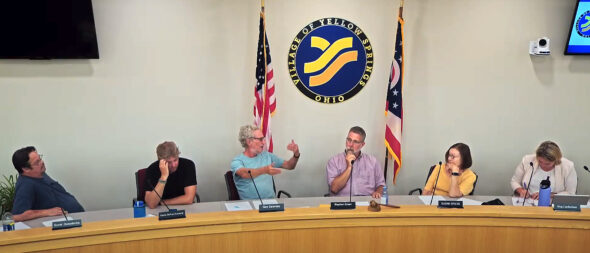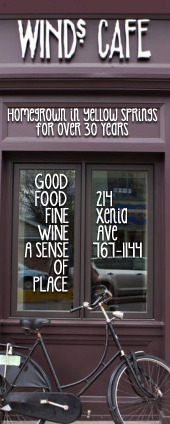
Present for the Aug. 12 Planning Commission meeting were, from left, Scott Osterhold, Gavin DeVore Leonard, Gary Zaremsky, Stephen Green, Susan Stiles and Planning and Economic Development Director Meg Leatherman. (Video still)
Planning Commission considers Airbnb changes to ‘prevent clustering’
- Published: August 19, 2025
At the most recent Planning Commission meeting, Tuesday, Aug. 12, the group again turned their attention to Airbnbs — how many Yellow Springs can sustainably have, and more specifically, how close they can be to one another.
At the time of reporting, Yellow Springs has 40 Airbnbs — known under the Village code as transient guest lodgings, or TGLs.
This summer, commissioners Gary Zaremsky and Stephen Green followed through on one of the Planning Commission’s 2025 goals to review the effectiveness of the Village’s TGL regulations.
Their research yielded compelling results: Of the eight other Ohio municipalities surveyed — cities, towns and villages with comparable populations and tourism-related pressures — Yellow Springs has the highest number of TGLs, despite having the strictest regulations among those towns surveyed.
“We have a relatively high number of TGLs,” Commissioner Zaremsky said at Tuesday’s meeting. “And we also have unique controls — the key feature of which is to minimize the clustering of TGLs.”
Zaremsky alluded to a 2021 Village ordinance — substantiated by Village Planning and Economic Director Meg Leatherman — that prohibits any new TGL from being established within 500 feet of another one, and an earlier ordinance that banned all new TGLs that are not “owner-occupied,” as well as the $2,000 annual fee for previously existing non-owner occupied TGLs and the annual $100 fee for owner-occupied TGLs.
The Planning Commission’s TGL study across Ohio included nearby municipalities such as Xenia and Beavercreek; more tourism-driven locales like Chagrin Falls, Peninsula and Nelsonville; and college towns like Mount Vernon, Granville and Sunbury.
Of the eight municipalities surveyed, Zaremsky’s data found that Beavercreek, with a population of 46,500 — about 12 times higher than Yellow Springs’ approximate population of 3,700 — had 25 TGLs. The lowest number of TGLs in the surveyed municipalities was a tie between Xenia — with a population of 25,400 — and Sunbury — with a population of 6,600 — each with 10 TGLs in their respective municipalities, and neither of which impose fees on owner- and non-owner occupied TGLs.
Despite that discrepancy between these municipalities and Yellow Springs, Zaremsky noted certain commonalities in his presentation on Tuesday.
“In so many of these towns, there are issues,” he said, adding that the people with whom he spoke inquired about potentially emulating Yellow Springs’ stricter regulations.
“[These municipalities] don’t control the spacing to a great degree,” Zaremsky told his colleagues on Tuesday. “They have units clustered together. There are concerns in their communities about it — regular, permanent residents who didn’t like the flow of so many people coming in and out.”
Those concerns, Zaremsky noted, echo those recently expressed in Yellow Springs-based online discussion boards and from past letter writers to the News who have articulated discontent with TGLs being established — at the alleged expense of potential long-term rental units within Yellow Springs.
“TGLs make more money than rentals,” Commission Chair Susan Stiles acknowledged.
Over the cource of discussion at the dais, Stiles and Zaremsky noted that a proliferation of TGLs within a given Yellow Springs neighborhood could “define” that residential area by having fewer permanent residents in favor of more folks coming and going.
On the other side of the coin, other local TGL owners have suggested in the same public forums — online and in print — that their sustained presence in town is subsidized by temporarily renting out accessory dwelling units to Yellow Springs visitors.
For the apparent majority of Planning Commission members on Tuesday, the sticking point was the proximity of the village’s existing 40 TGLs, and of any that may crop up in the future.
“Proportionally, we have more than any of these other communities,” Stiles said. “We’re concerned about the loss of affordable housing.”
To amend that loss, and potentially to prevent what he described as TGLs “clustering” in a given neighborhood, Zaremsky proffered a suggestion: Modify the Village’s 500-foot TGL restriction from the measurements of the property lines — or, “as the crow flies,” as previously described in past News reporting — to a 500-foot measurement along the roadway.
At present, the Village code reads: “In no case can a transient guest lodging be located closer than 500 feet from another transient guest lodging, as measured from the closest property line to closest property line.”
Should the Village adopt Zamersky’s suggestion of measuring the distance between TGLs from the street rather than property lines, that could limit the number of TGL applications moving forward.
Most commissioners were in agreement with Zaremsky’s proposal, except for Stephen Green who suggested the change would be ineffectual towards the group’s purported goal of limiting TGLs.
“This is a blunt instrument to achieve what we’re trying to achieve,” he said.
The group took no vote on the matter on Tuesday, but resolved to address it again at their next meeting on Tuesday, Sept. 9, when Planning and Economic Development Director Leatherman will present a drafted code amendment regarding TGL spacing, along with other zoning code requirements.
The Yellow Springs News encourages respectful discussion of this article.
You must login to post a comment.
Don't have a login? Register for a free YSNews.com account.















No comments yet for this article.